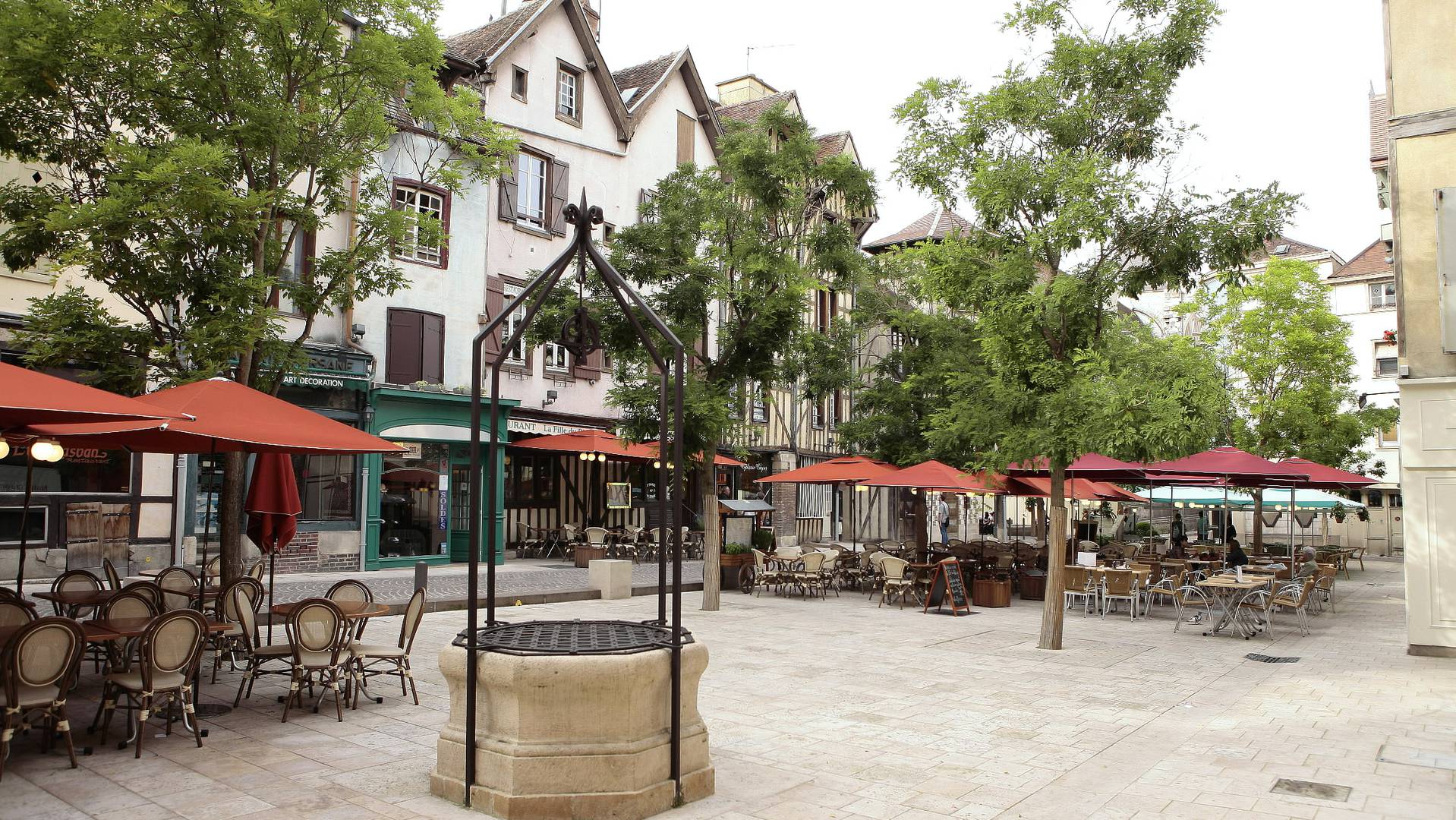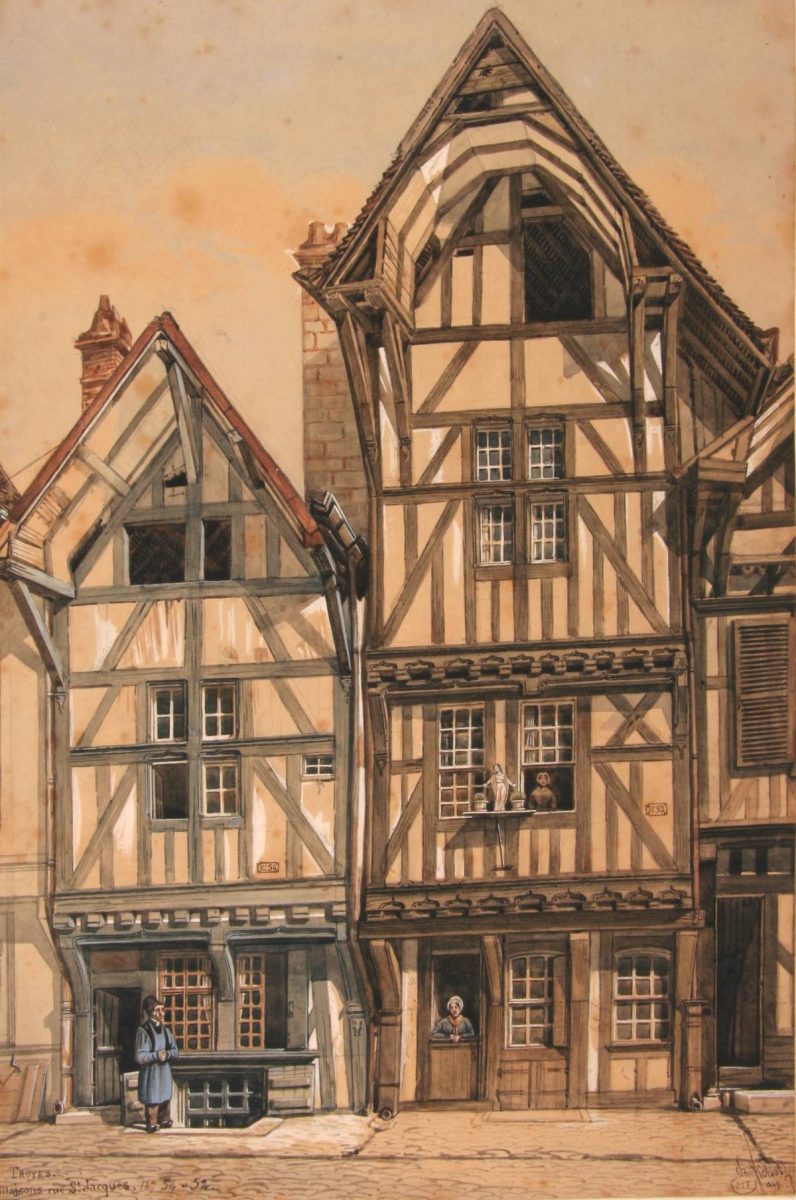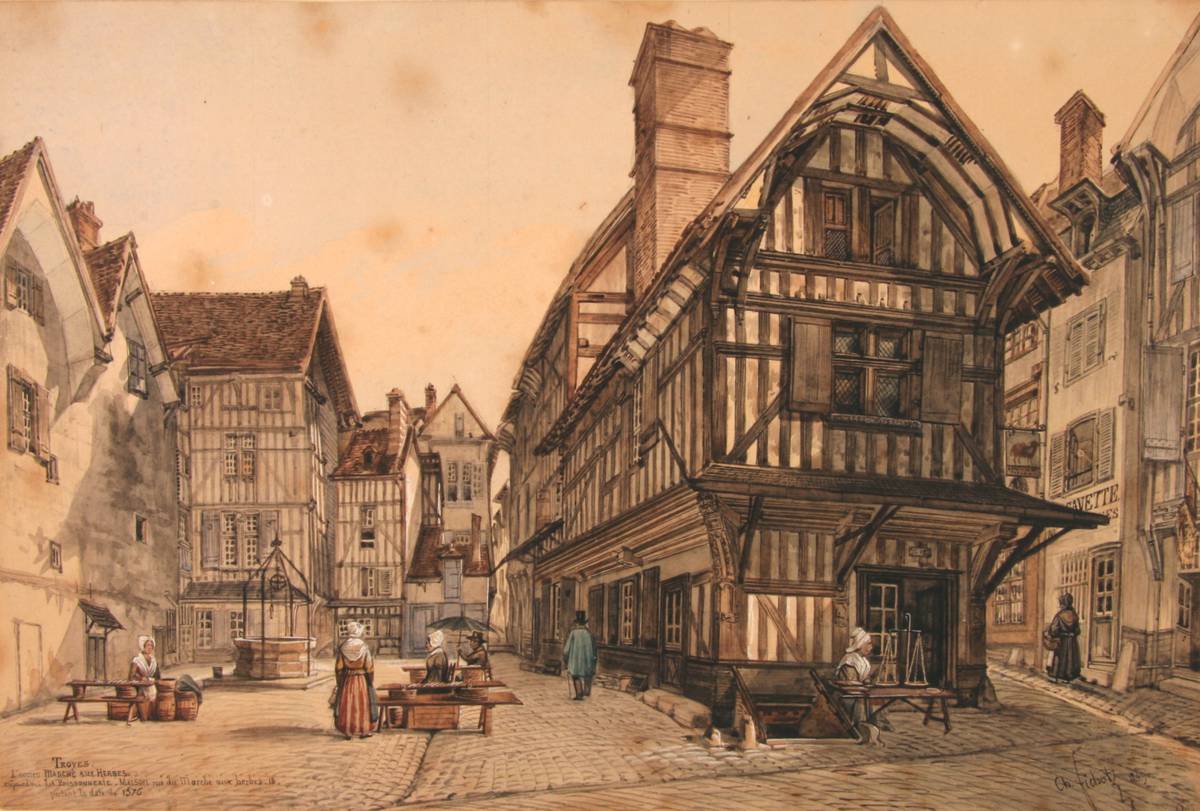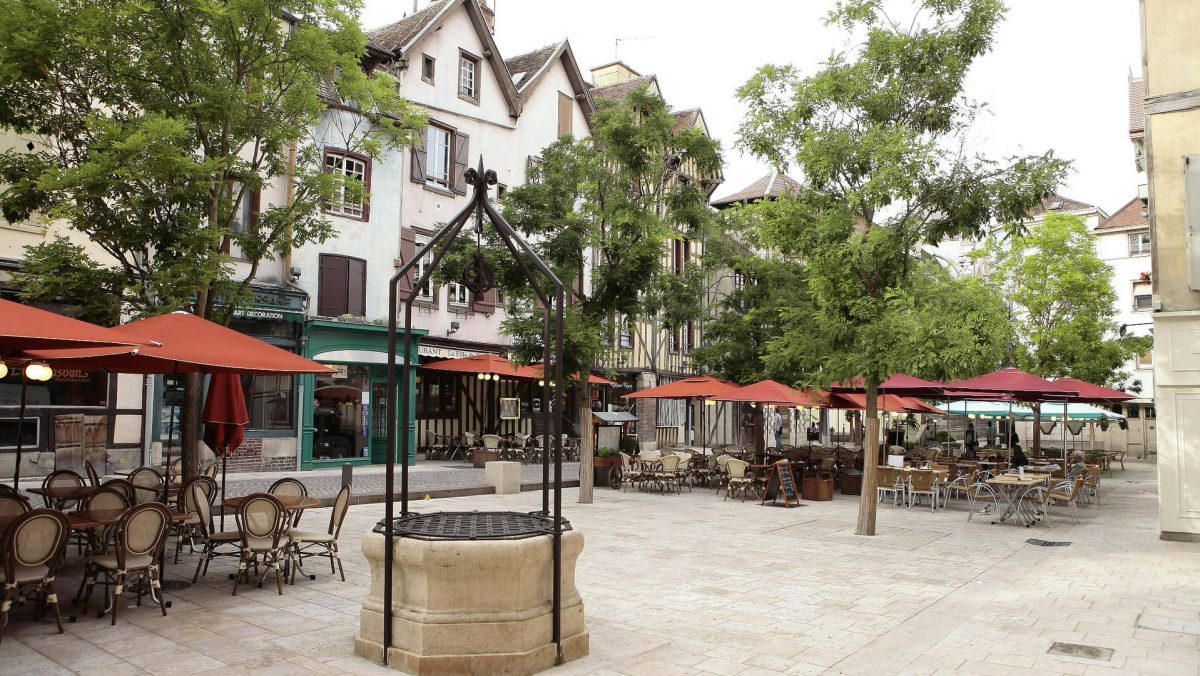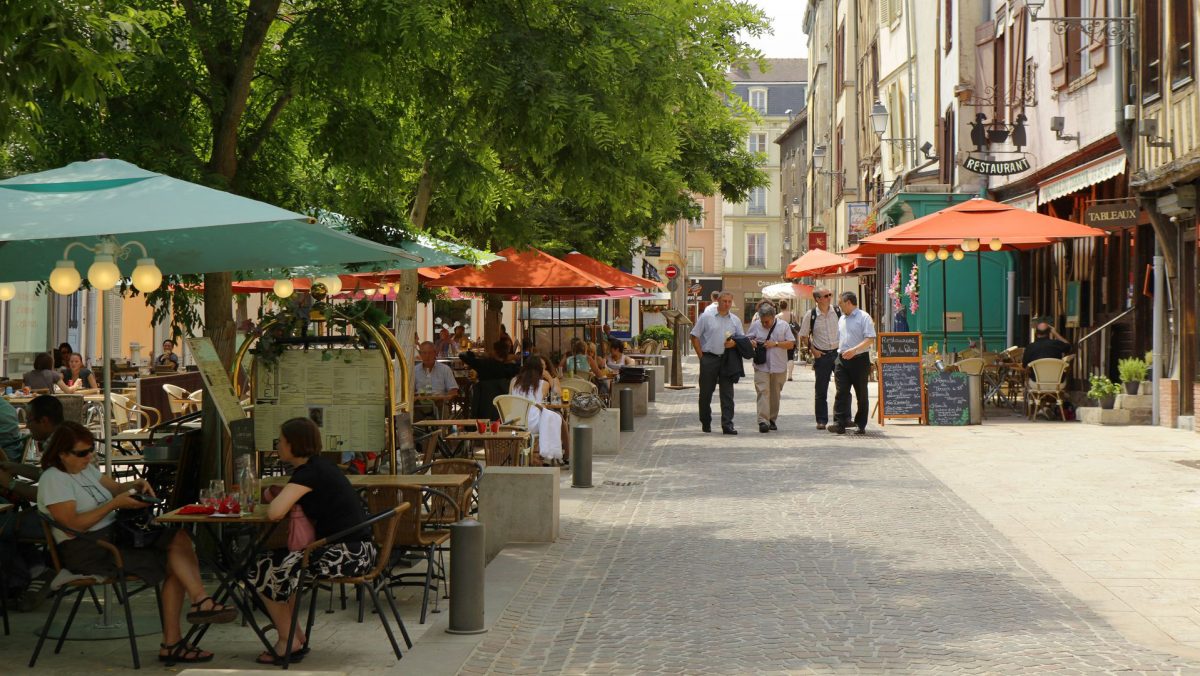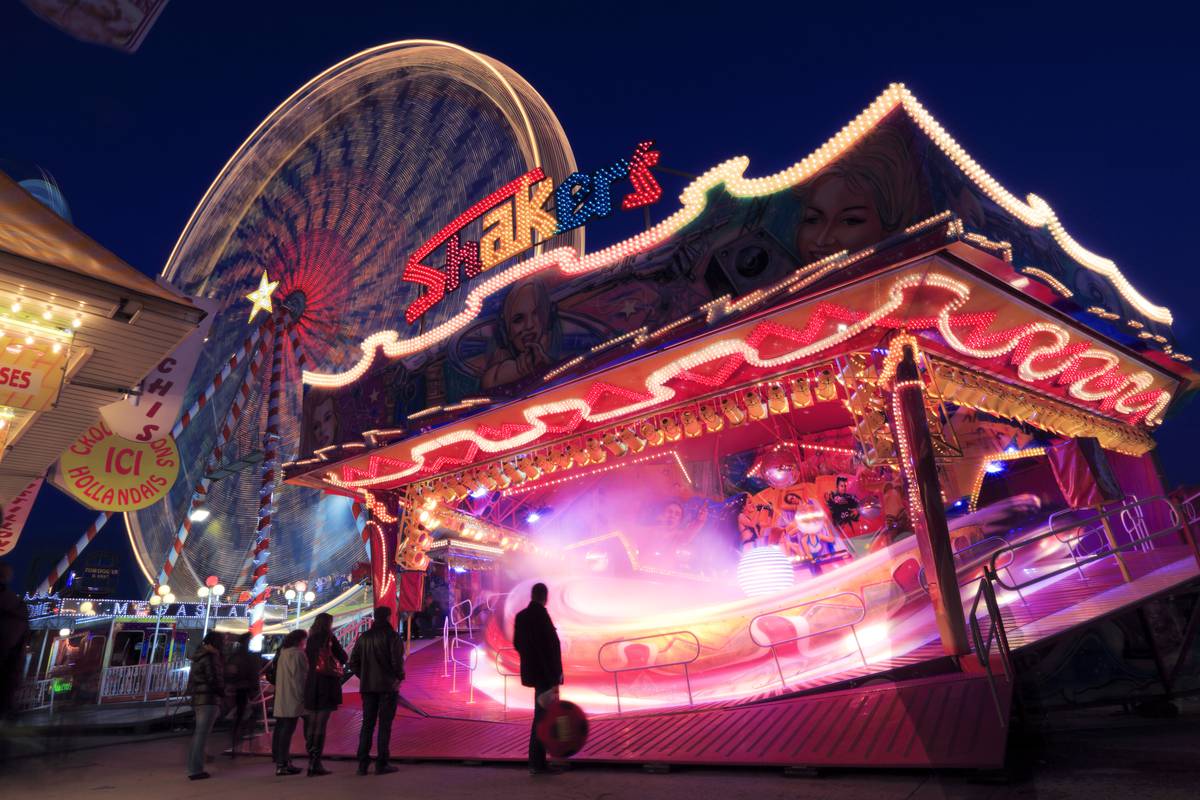The Champagne Fairs and Saint-Jean-au-Marché district
It is mainly in the urban fabric that we find the memory of the era of the great Champagne Fairs. They were held over several weeks. Summer fairs began on Saint Jean’s Day. Winter fairs started on Saint Remi’s Day in October. The tangled streets, squares and enclosed courtyards give an idea of what the town looked like at that time.
Some street names
– that haven’t changed since the Middle Ages – would even be familiar to the merchants of the time, such as “la rue de la Montée des Changes”, “la rue Champeaux”, “la rue de la Pierre” and “la rue des Anciennes Tanneries”, all evoking things as they were at that time, and the merchants would doubtless recognise the silhouette of the Troyes houses rebuilt identically in the 16 c. with their corbelled roofs and their mullioned windows and their timber and cob walls, materials commonly used in mediaeval architecture in the Champagne region.
The majority of these houses have kept their cellars and their vaults, some on two levels were probably used by merchants and drapers.
Sacred architecture
From XII and XIII c., there are also elements of sacred architecture, demonstrating the fervour and faith of these men. There is much evidence of the donations of prosperous merchants. In the courtyard in the quarter of the Fairs, the nave of the Saint Jean-au-Marché church, the tower of the Saint Rémi church and a large part of the church of Sainte Madeleine, the Saint Urbain basilica(1262-1286) and its stained glass windows mark the whole of this period. Started before the end of the XII c., the Cathedral continued to be built during the following century. Some of its glass is from this period along with its treasure in which there is a fine collection of Limousin and Mosan enamels from the XII and XIII c.
During the Great Fairs, Troyes was a formidable place for commercial exchanges and also a meeting place where men’s ideas were encountered. This intellectual effervescence can be measured partly through their written records in the ancient stores of the Troyes library. This library also houses the library of Count Henry 1st the Liberal and his wife, Marie de Champagne, the first princely French library within knowledge since Charlemagne…
In the Middle Ages the Counts of Champagne encouraged the prosperity of commercial exchanges; they instituted rules concerning the manner in which the fairs were to be conducted and the policing of the markets, ensuring the safety of the travellers, the traders and the good faith of the operations carried out, with six great fairs spread over a whole year: 2 at Provins, 1 at Lagny, 1 at Bar-sur-Aube and 2 very large ones at Troyes(the St Jean Hot Fair and the St Rémi Cold Fair).
Money-changers and bankers played an important role, since only the money of the Counts and the King was allowed. The Counts also protected the Jewish community, where RACHI came from. The Saint-Jean-au-Marché church was the centre of the Fairs quarter. Certain street still have evocative names, Rue de la Montée des Changes, Place du Marché au Pain.
These fairs were the meeting place for the whole of the Western world: there were Flemish, English and Spanish wools, silks, leathers, furs, spices, precious woods and gold and silver wares.
Troyes: a former powerhouse of trade and finance
The city of Troyes played a key role in the birth of international trade at the dawn of the second millennium.
Merchants from across Europe and overseas would, by necessity, pass through Troyes. Known as the “cité tricasse” by virtue of the Tricasses (the warriors who settled here), the city was famous for its markets and became a financial powerhouse. Such was its economic clout that it held a position rivalled only by the City of London today.
To this day, the English-speaking world still uses a unit of measure first developed in this bygone era to weigh precious metals: the “Troy ounce”, whose name is a clear indication of its origin.
Globalisation was invented a thousand years ago right here in Troyes. This is a rather over-simplified claim, of course, but it is founded in truth. Troyes was once a focal point of international trade and a financial powerhouse that held real clout in the 12th and 13th centuries.
Merchants from across Europe, and even some from further afield, would congregate on the city to sell their wares. The city stood at an important crossroads between Bruges, Venice, Paris and the Germanic lands. Troyes had a normal population of 10,000 to 20,000 – a considerable number for the time – and this was swelled each year by an influx of a thousand foreigners.
It was the time of the famous Champagne Fairs – a tradition that survives, albeit in a very different format, to this day.
Trade has always been one of the most human instincts, both here in Troyes and elsewhere in the world. But what makes the city stand out is the way in which those in power sought to develop trade and make the city a prosperous place through careful planning and organisation.
The local lords improved communication routes, built market halls and squares, set regulated weights and measures systems and introduced a single currency – the denier provinois – for all transactions. They also offered legal protection, provided by the so-called Conduit des Foires, to guarantee the safety of merchants and their goods, even beyond the county boundaries, at a time when ambushes and murders were commonplace.
Even the king himself provided personal protection for the merchants. The fairs were spread across four towns, and a total of six markets were held in Troyes and Bar-sur-Aube (in Champagne) and Lagny and Provins (in Brie, now known as Seine-et- Marne). This ensured that trading activity continued non-stop throughout the year.
Troyes played host to two fairs: the “hot fair” (or Saint-Jean fair), which was held in summer, and the “cold fair” (or Saint-Rémy fair), which took place in winter. Each fair would last for up to two months.
In fact, they were less like fairs and more like huge bazaars, where merchants would buy and sell a vast array of goods, including wine, cloth, coal, beasts of burden, precious stones and medicinal remedies. According to one historian, there were no fewer than 12 categories of goods on sale at these fairs. King Charles IX stated that “Troyes is the warehouse of Europe’s great trading regions”.
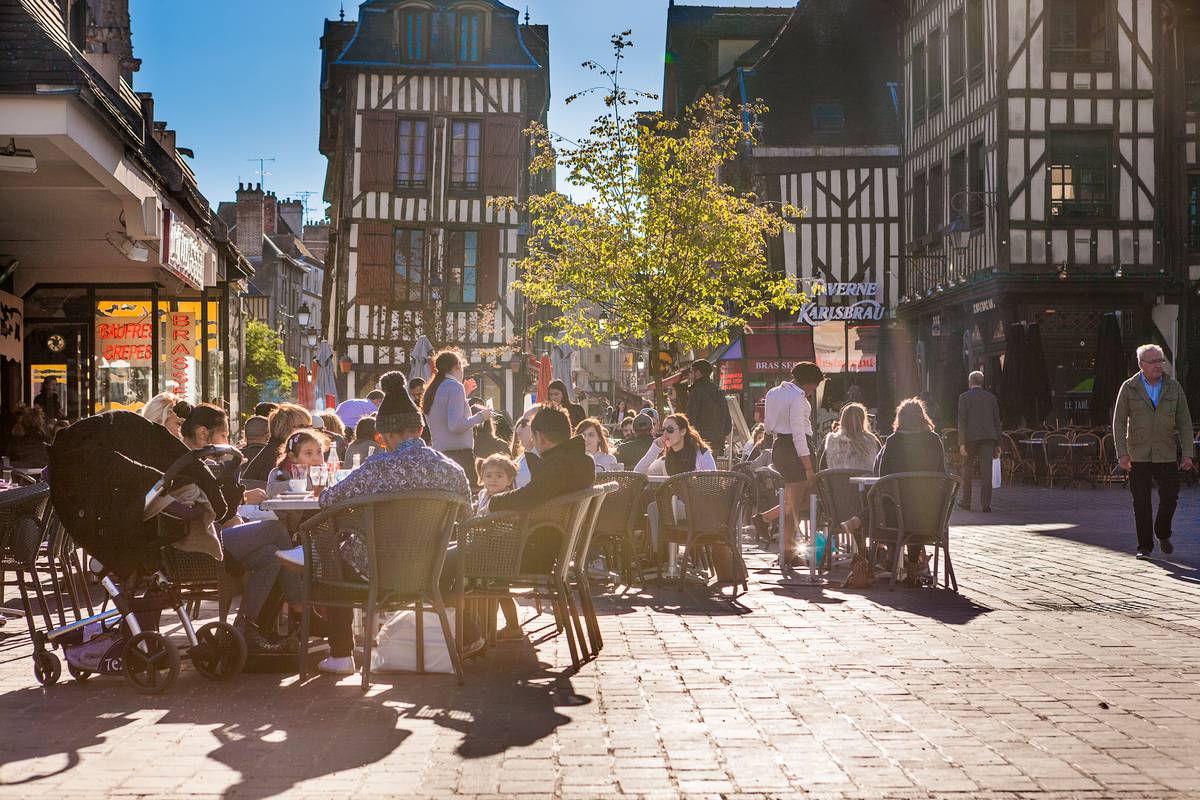
The “Troy ounce” still holds weight today
Here’s a riddle for you: what weighs exactly 0.0311034768 kilograms? You might think that this seemingly arbitrary value is taken from the imperial system, something conjured up by the British. That is partially, if not entirely, correct.
In fact, 31.103 grams (rounded down) is the weight of the “Troy ounce”, the unit of measure used to weigh gold, silver, platinum and precious stones in English-speaking countries. And you might have guessed that the “Troy” in “Troy ounce” is nothing to do with the ancient city of Troy, but rather the French town of Troyes.
In fact, the Troy ounce was a unit of measure used in the Champagne Fairs, and it still remains with us to this day. With a value of one twelfth of a “Troy pound”, it was used to weigh all sorts of objects and foodstuffs during the Middle Ages. At a time when there was no such thing as banknotes and where weights and measures varied dramatically from one city to the next, the introduction of a standardised unit of measure with a defined monetary value represented real progress.
The fact that the Troy ounce survives to this day is testament to the importance of the Champagne Fairs across the Christian world and their influence on trade and commerce on the 12th and 13th centuries. The unit of measure has long since fallen out of use in France, following the introduction of the modern metric system during the French Revolution.
Another unit of weight employed during the fairs, the Troy mark, has also enjoyed an illustrious career. At 244.75 grams, it was used for the manufacture of royal books. The denier provinois, meanwhile, was the currency of the Counts of Champagne and has often been referred to by historians as the “dollar of the Middle Ages”.
The hot and cold fairs make a comeback
If you thought the Champagne Fairs had disappeared forever in the 13th century, think again! They still exist today, and they are still known by their original name: the Foires de Champagne. These days, they take the form of a vast exhibition-cummarket, held in Troyes in late spring each year. They attract crowds of shopkeepers and craftsmen, and feature performances from concert singers and pop-up restaurants.
Tradespeople come to promote their wares, while clubs and associations showcase their interests and activities through various stands, exhibitions, events and games.
In short, it is a joyful hive of activity that evokes a similar atmosphere to the fairs of yesteryear, echoing the noise and colour of the Middle Ages. And in yet another nod to their glorious cosmopolitan predecessors, today’s Champagne Fairs focus on a different country each year.
The “March faire”
And that’s not all, because Troyes plays host to other “fairs” too… Just like the “hot fair” and “cold fair” in years gone by, Troyes now holds its very own “March fair”.
This event is a vast fun fair, and marks the opening of the season in north-eastern France. It features a roller coaster, a ghost train and dodgems, and Troyens still use the term “going to the fair” to this day. It is a phrase that evokes the city’s past and demonstrates how this unique vocabulary has remained etched into our collective subconscious.
And if that’s not enough to satisfy your appetite, Troyes has even more to offer. Who can deny that the city’s extraordinary concentration of factory outlets, now fashion stores known collectively as “brand outlet centres” and discussed elsewhere in this publication, are anything but a reflection of Troyes’ past?
For trade in cloth, silk and other textiles was the central feature of the medieval Champagne Fairs themselves…
